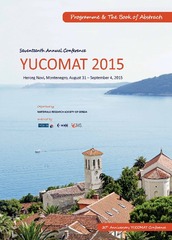Приказ основних података о документу
Platinum Nanocatalysts at Titanium Oxide Based Supports for Low Temperature Fuel Cell Applications
| dc.creator | Gajić Krstajić, Ljiljana | |
| dc.creator | Elezović, Nevenka | |
| dc.creator | Babić, Biljana M. | |
| dc.creator | Radmilović, Velimir R. | |
| dc.creator | Krstajić, Nedeljko | |
| dc.date.accessioned | 2017-06-10T15:45:07Z | |
| dc.date.issued | 2015 | |
| dc.identifier.uri | https://dais.sanu.ac.rs/123456789/825 | |
| dc.description.abstract | A comparative study on catalytic activity of platinum nanoparticles on different titanium oxide supports for proton exchange membrane fuel cells reactions was performed. Non stoichiometric titanium oxides – Ebonex, niobium doped titanium oxide and ruthenium doped titanium oxide were applied as the supporting materials. Platinum nanocatalysts (20% Pt) on different support were synthesized by impregnation or borohydride reduction method. Synthesized supports and catalyst were characterized by BET (Brunauer, Emmett, Teller), X-ray diffraction (XRD) and high resolution transmission electron microscopy (HRTEM). Homogenous Pt nanoparticles distribution over the niobium and ruthenium doped TiO2 support, without pronounced particle agglomeration was confirmed by HRTEM technique. The average Pt particle size was 3 nm and 5.4 nm for Pt at niobium doped TiO2 and ruthenium doped TiO2, respectively. However, it was not possible to determine accurately average Pt particle size at Ebonex support, due to the non-uniform distribution of the Pt nanoparticles. Electrochemically active Pt surface area of the catalysts was determined by integration of the cyclic voltammetry curve in the potential region of underpotential deposition of hydrogen, after double layer charge correction, taking into account the reference value of 210 μC cm-2 for full monolayer coverage. Kinetics of the oxygen reduction reaction at Pt nanocatalysts on different titanium based supports was studied by cyclic voltammetry and linear sweep voltammetry at rotating gold disc electrode. Two different Tafel slopes at Pt catalysts on niobium and ruthenium doped supports were observed: one close to 60 mV dec-1 in low current density region, and other ~120 mV dec-1 in higher current densities region. Only at Ebonex based support one single Tafel slope (~ 106 mV dec-1) was observed. The specific activities for oxygen reduction, expressed in terms of kinetic current densities per electrochemically Pt active surface area, as well as per mass of Pt loaded, at the constant potential of practical interest (0.85 V and 0.90 V vs RHE, where the mass transport contribution current can be neglected), were compared to carbon supported one, with the same Pt loading. Stability tests, by repetitive cycling from 0.03V to high anodic potentials (up to 1.4 V vs RHE) were performed. The advantages of carbon free supports application in terms of stability, durability and life time of the catalysts were discussed. | en |
| dc.format | (2015) 77-77 | |
| dc.format | application/pdf | |
| dc.language | en | |
| dc.publisher | Belgrade : Materials Research Society of Serbia | |
| dc.relation | info:eu-repo/grantAgreement/MESTD/Basic Research (BR or ON)/172054/RS// | |
| dc.rights | openAccess | |
| dc.rights.uri | https://creativecommons.org/licenses/by-nc-nd/4.0/ | |
| dc.source | Programme and The Book of Abstracts / Seventeenth Annual Conference YUCOMAT 205, Herceg Novi, August 31– September 4, 2015 | en |
| dc.subject | nanocatalysts | |
| dc.subject | platinum nanoparticles | |
| dc.subject | titanium oxide | |
| dc.subject | fuell cells | |
| dc.title | Platinum Nanocatalysts at Titanium Oxide Based Supports for Low Temperature Fuel Cell Applications | en |
| dc.type | conferenceObject | |
| dc.rights.license | BY-NC-ND | |
| dcterms.abstract | Елезовић, Невенка; Гајић Крстајић, Љиљана; Бабић, Биљана; Радмиловић, Велимир; Крстајић, Недељко; | |
| dc.citation.spage | 77 | |
| dc.citation.epage | 77 | |
| dc.type.version | publishedVersion | |
| dc.identifier.fulltext | https://dais.sanu.ac.rs/bitstream/id/21782/822.pdf | |
| dc.identifier.rcub | https://hdl.handle.net/21.15107/rcub_dais_825 |

